Chapter: Physics : Magnetic and Superconducting Materials
Important Questions and Answers: Magnetic and Superconducting Materials
SHORT
QUESTIONS WITH ANSWERS
1.Define Magnetic Flux.
The total
number of number magnetic lines of force passing through a surface is known as
magnetic flux.
Unit: Weber.
2.Define magnetic induction (B) or magnetic flux
density.
It is the
number of magnetic lines of force passing through unit area of cross section.

3.Define Magnetic field strength or Magnetizing
field.
It is the
force experienced by a unit North Pole placed at a given point in a magnetic
field. The magnetic induction B due to the magnetic field of intensity H
applied in vacuum is related by

4.Define intensity of magnetization (I)
Magnetization
is the process of converting a non-magnetic material in to a magnetic material.
It is also defined as the magnetic moment per unit volume.
I = m /
V.
Unit : Web / m2.
5.Define Magnetic permeability (
It is the
ratio of the magnetic induction (B) to the applied magnetic field intensity(H)
μ = B/H
Unit : Henry m–1.
6.Define relative permeability(μ)
It is defined as the ratio of permeability of the medium to the permeability of the free space(μr).
μr=μ/μo
7.Define magnetic susceptibility.
It is defined as the ratio of intensity of magnetization (I) and intensity of magnetic field (H). χ= I / H. The sign and magnitude of χ are used to determine the nature of the magnetic materials.
8. Define Bohr magnetron(μB)
The
orbital magnetic moment and the spin magnetic moment of an electron in an atom
can be expressed in terms of atomic unit of magnetic moment called Bohr
magneton.

9. How the
magnetic materials are classified?
The
magnetic materials are classified into two categories.
The
materials without permanent magnetic moment
Example: 1.
Diamagnetic materials.
The materials
with permanent magnetic moment.
Example: 1.
Paramagnetic materials
Ferromagnetic materials
Anti-Ferromagnetic materials
Ferrimagnetic materials.
10.Define Diamagnetic Materials.
In a
diamagnetic material the electron orbits are randomly oriented and the orbital
magnetic moments get cancelled. Similarly, all the spin moments are paired
i.e., having even number of electrons. Therefore, the electrons are spinning in
two opposite directions and hence the net magnetic moment is zero. These materials
are called as diamagnetic materials.
Example: Gold,
germanium, silicon, antimony, bismuth, silver, lead, copper, hydrogen,
Water and alcohol.
11.Define Paramagnetic Materials.
Para
magnetism is due to the presence of few unpaired electrons which gives rise to
the spin magnetic moment. In the absence of external magnetic field, the
magnetic moments (dipoles) are randomly oriented and possess very less
magnetization in it. When an external magnetic field is applied to paramagnetic
material, the magnetic moments align themselves along the field direction and
the material is said to be magnetized.
Example: Platinum,
CuSO
4 , MnSO4 Palladium, Chromium, Aluminum, etc
12. Define Ferromagnetic Materials.
Ferromagnetism
is due to the presence of more unpaired electrons. Even in the absence of
external field, the magnetic moments align parallel to each other. So that it
has large magnetism. This is called spontaneous magnetization.
Example: Nickel,
iron, Cobalt, Steel, etc.
13. What is the Effect of magnetic field on
Ferromagnetic materials?
If a
small external magnetic field is applied the magnetic moments align in the
field direction and become very strong magnets.

14.What are the properties of Ferromagnetic
Materials?
1. All the magnetic lines of force pass through
the material.

The permeability is very much greater than one.
They have enormous permanent dipole moment.
When the temperature is greater than the Curie
temperature, the Ferromagnetic material becomes paramagnetic material.
The ferromagnetic material has equal magnitude
dipole lying parallel to each other.
Examples:
Nickel,
iron, Cobalt, Steel, etc.
15.What are magnetic domains?
A
ferromagnetic material is divided into a large number of small regions called
domains. (0.1 to 1 mm2 of area). Each direction is spontaneously
magnetized. The direction of magnetization varies from domain to domain and the
net magnetization is zero in the absence external magnetic field. The boundary
line which separates two domains is called domain wall or Block wall.
16.Define Exchange Energy.
The
energy which makes the adjacent dipoles to align themselves is known as
exchange energy. It is also called as magnetic field energy or magneto static
energy. It arises from interaction of electron spins and it depends upon the
inter atomic distance.
17.What is Anisotropy energy?
Crystals
are anisotropic, the energy arises from the difference of energy required for
magnetization along any two different directions in a single crystal. These are
two directions of magnetization.
1. Easy direction. 2.
Hard direction.
In easy
direction of magnetization, weak field can be applied and in hard direction of
magnetization, strong field should be applied.
The
excess energy required to magnetize a specimen in particular direction over
that required to magnetize it along the easy direction is called the
crystalline anisotropy energy.
18.What is Domain wall energy (or) Bloch wall
energy?
It is the
sum of the exchange and anisotropy energy in the domain wall. Thickness of the
wall is approximately 1000o A
19.What
is Magnetostriction energy?
When the
domain is magnetized in different directions, they will either expand or
shrink. i.e., Change in dimension
when it is magnetized. The energy produced in this effect is called
Magnetostriction energy. It is the energy due to the mechanical stresses
generated by domain rotations.
20.Give the experimental evidence for Domain
Structure?
An
experimental evidence for domain structure was given by BITTER and is called Bitter powder pattern. In this method, a drop
of colloidal suspension of finely divided ferromagnetic powder is allowed to
spread over the surface of the ferromagnetic material. It is found that through
the microscope, the colloidal particles are collected along the domain
boundaries which shows the existence of domain structure.
21.Define Hysteresis.
Hysteresis
means “Lagging” i.e., The Lagging of intensity of magnetization (I) behind the
intensity of magnetic field (H) which is applied is called Hysteresis.
22. What is meant by Hysteresis Loss?
When the
specimen is taken through a cycle of magnetization, there is loss of energy in
the form of heat. This is known as Hysteresis Loss.
23. Define Retentivity and Coercivity.
During
the process of demagnetization, the material retains some amount of magnetism,
even though when intensity of magnetic field is zero. It is known as
Retentivity or residual magnetism.
The
amount of intensity of magnetic field applied in the reverse direction to
remove the retentivity is known as coercivity
or coercive force.
24.What are reversible and irreversible domains?
When a
magnetic field is applied, the domain walls are displaced and gives rise to
small value of magnetization. Now if the field is removed, the domains return
to its original state and are known as reversible domains.
When the
field is removed certain domain boundaries do not come back to the original
position due to the domain wall movement to a very large distance. These
domains are called irreversible domains.
25.What are soft magnetic materials? Give its
properties?
Soft
Magnetic materials: Materials which are easy to magnetize and
demagnetize are called soft magnetic materials.
These
materials do not retain the alignment of magnetic domains after the removal of
external magnetic field.
Properties
They have high
Permeability
The storing of magnetic energy is less
Retentivity and Coercivity values are small
They have low
hysteresis loss
26.What are hard magnetic materials? Give its
properties?
Hard
Magnetic materials: Materials which retain their
magnetism and are difficult to demagnetize are called hard
magnetic materials.
These
materials retain permanently the alignment of magnetic domains even after the
removal of external magnetic field.
Properties
They have low
Permeability
The storing of magnetic energy is more
Retentivity and Coercivity values are high
They have high
hysteresis loss
27. Define Energy product.
The
product of residual magnetic induction (Br) and coercivity (HC)
is called energy product (Br × HC). The value of energy
product is very high for permanent magnets.
Importance:
It is used to design powerful permanent magnets
It is used to maximum amount of energy stored in
the specimen
28.Distinguish between Soft and Hard magnetic
material.
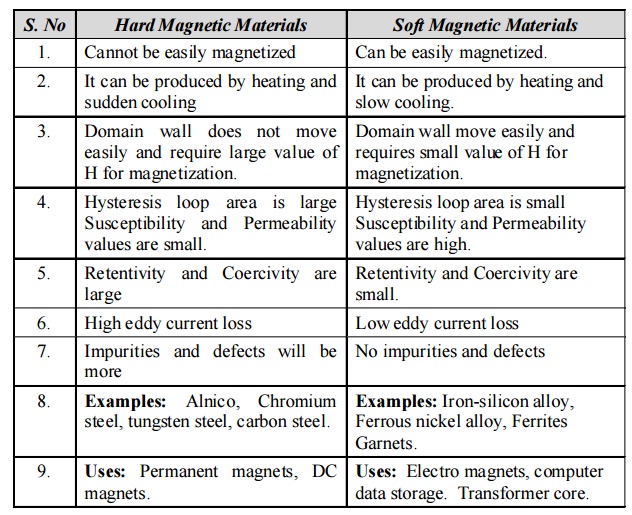
S. No
Hard Magnetic Materials
1. Cannot
be easily magnetized
2. It can
be produced by heating and sudden cooling
3. Domain
wall does not move easily and require large value of H for magnetization.
4.
Hysteresis loop area is large Susceptibility and Permeability values are small.
5.
Retentivity and Coercivity are large
6. High
eddy current loss
7.
Impurities and defects will be more
8.
Examples: Alnico, Chromium steel, tungsten steel, carbon steel.
9. Uses:
Permanent magnets, DC magnets.
Soft
Magnetic Materials
1. Can be
easily magnetized.
2. It can
be produced by heating and slow cooling.
3. Domain
wall move easily and requires small value of H for magnetization.
4.
Hysteresis loop area is small Susceptibility and Permeability values are high.
5.
Retentivity and Coercivity are small.
6. Low
eddy current loss
7. No
impurities and defects
8.
Examples: Iron-silicon alloy, Ferrous nickel alloy, Ferrites Garnets.
9. Uses:
Electro magnets, computer data storage. Transformer core.
29. Define Anti ferromagnetic materials.
Magnetic
materials in which, the spins are aligned in anti-parallel manner due to un
favorable exchange interaction among them resulting in zero magnetic moment are
called as Anti ferromagnetic materials.
30. What are Ferrimagnetic materials or Ferrites?
Ferromagnetic
materials are much similar to ferromagnetic materials in which the magnetic
dipoles are aligned anti-parallel with unequal magnitudes. If small value of
magnetic field is applied, it will produce the large value of magnetization.
31. What are the Applications of Ferrites?
Ferrites are used to produce ultrasonic wave by
Magnetostriction principle.
Ferrites are used in audio and video transformers.
Ferrites rods are used in radio receivers to
increase the sensitivity.
Ferrites are widely used in non-reciprocal
microwave devices such as gyrator, circulator and Isolator.
They are also used for power limiting and harmonic
generation.
Ferrites are used in parametric amplifiers so that
the input can be amplified with low noise.
They are used in computers and data processing
circuits.
32. What Magnetic Bubbles?
Magnetic
bubble is direct access storage medium. Magnetic bubbles are soft magnetic
materials with magnetic domains of a few micrometers in diameter. These bubbles
are the electrical analogue of the magnetic disk memories used in computers.
The magnetic disk in the hard disk memory is moved mechanically where as the
bubbles in a bubble memory device are moved electronically at very high speeds.
31.What is Superconductivity?
The
ability of certain metals and alloys exhibit almost zero electrical resistivity
when they are cooled to low temperature is known as superconductivity. (ie.,
maximum conductivity with zero resistance at zero Kelvin)
34. Define Critical Temperature.
Critical
temperature (or) Temperature ( TC ) is defined as the temperature at
which the resistivity falls to zero is called transition as temperature or
Critical temperature. The temperature at which the normal conductor becomes a
superconductor is know as critical temperature ( TC ) Below TC
, the material (Tin) is in the superconducting state and above TC ,
it is in the normal state.
35.State BCS Theory?
(Bardeen, Cooper and Schrieffer
theory). It states that an electron pair called cooper pair is formed at low temperature by overcoming the
repulsive force. The cooper pair moves without scattering (without any
resistance) in the lattice structure. Now the material becomes a super
conductor.
This is
also called as electron-phonon- electron interaction. these two electrons have
equal and opposite momentum and spins.
This BCS
theory is suitable only for low temperature superconductors.
36. Define Cooper pair.
The
electron pairs called cooper pairs are formed at low temperature by overcoming
the repulsive forces. The cooper pairs moves without scattering (without any
resistance) in the lattice structure. Now the material becomes super conductor.
This is also called as electron-phonon- electron interaction these two
electrons have equal and opposite momentum and spins.
37.What is coherence length?
It is
defined as the distance up to which two electrons combine to form a Cooper
pair.
38.What are the important properties of
superconductors?
1. Zero
Electrical Resistance : The electrical resistivity drops to zero at the transition temperature.( TC ) Dr. Collins
observed that the current in a superconducting ring is unchanged for 2½ years.
2. Effect
of magnetic field : Below TC , the superconducting property disappears when
strong magnetic field is applied. i.e., it returns to normal state.
3.
Diamagnetic property : The superconductor is a perfect diamagnetic.
4. Effect
of heavy Current : The superconducting property disappears when a heavy current
flows, since current flow will set up a magnetic field.
5.
Isotope effect : The presence of isotopes in superconductors changes the
transition temperature of the superconductors.
6.
Thermal properties : Entropy and specific heat decreases at transition
temperature and the thermoelectric effect disappear in the superconducting
state.
7. Effect
of Impurities : The impurities change the magnetic properties of the
superconductors.
39.Define Critical magnetic field.
A very
strong magnetic field applied to superconducting material it disappears
superconducting property this is called as critical magnetic field.

When the
temperature of the material increases, the value of critical magnetic field
decreases.
40. What is Meissner effect? (or) Define
Diamagnetic property.
When the
superconducting material is subjected to a uniform magnetic field, under the
condition T TC and H HC, the magnetic flux lines are
excluded from the material. Thus the material exhibits perefect diamagnetism.
This phenomenon is called as meissner effect.
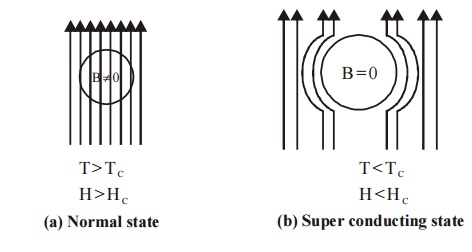
41. What happens in a superconductor when a heavy
Current flows?
The
superconducting property disappears when a heavy current flows, since this
current flow will set up a heavy magnetic field. According the Silsbee’s rule,
for a superconducting wire

42. What is Isotope effect?
The
presence of isotopes in superconductors change the transition temperature of
the superconductor. The transition temperature is found to be inversely
proportional to the square root of the atomic weight of the isotope.
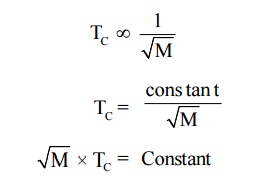
The
transition temperature of the heavier isotope is less than the that of the
lighter isotopes.
43. How the superconductors are classified? or what
are the types of superconductors.
Based on
the value of HC we have,
1) Type I
(or) Soft superconductors 2) Type II (or) Hard superconductors
Based on
the value of TC we have,
1) High
temperature superconductors 2) Low temperature superconductors
44.What it Type I superconductors? Give its
characteristics.
In type I
superconductor, the magnetic field is completely excluded from the material
below the critical magnetic field HC and the material loses its
superconducting property abruptly at HC .
Characteristics
They exhibit complete Meissner Effect.
They have only one critical magnetic field value.
Below the material behaves as superconductor and
above the material behaves as normal conductor.
These are called as Soft superconductors.
45. Distinguish between Type I and Type II
Superconductors
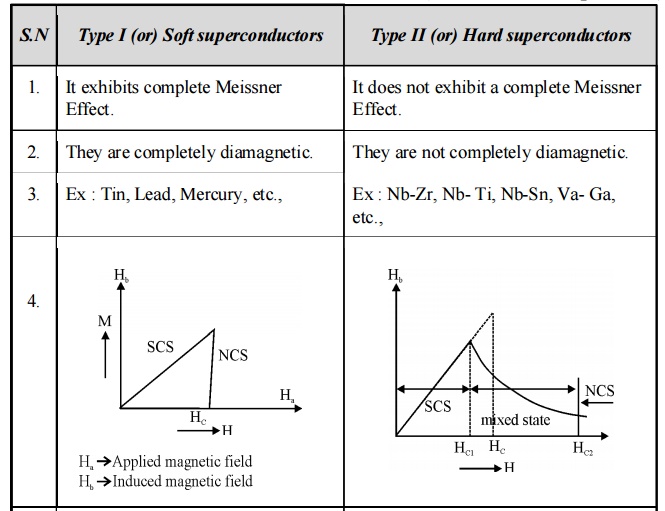
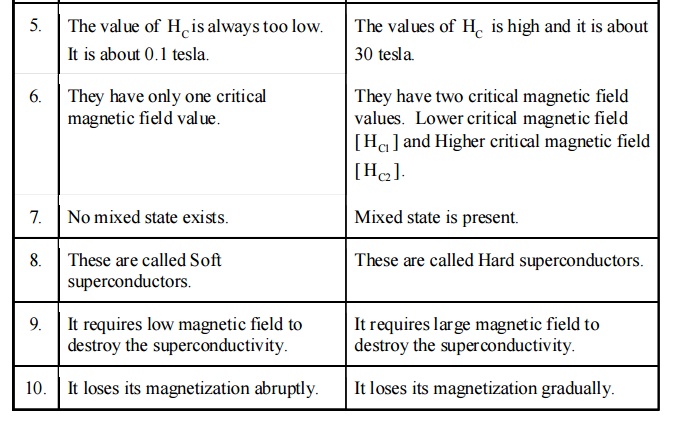
What it
Type II superconductors? Give its characteristics.
In type
II superconductor, the magnetic field is excluded from the material and the
material loses its superconducting property gradually rather than abruptly.
Characteristics
They do not exhibit a complete Meissner Effect.
They have two critical magnetic field values. Lower
critical magnetic filed [HC1] and Higher critical magnetic field [HC2].
Below HC1 the material behaves as
superconductor and above the material behaves as normal conductor. The region
in between [HC1] and [HC2] is called mixed state or
vortex region.
These are called as Hard superconductors.
46.What are Low TC and High TC
superconductors?
Low TC
Superconductors
The superconductors having the critical temperature
less than 20 K are known as low TC Superconductors or elemental
superconductors.
The Superconductors by BCS theory.
It is explained by BCS theory.
It is not so useful due to its low temperature
maintenance.
It is called as N-type superconductor.
High TC
Superconductors
The superconductors having the critical temperature
greater than 100 K are known as high TC Superconductors or ceramic
or oxide superconductors.
The Superconductors is due to hole states.
It is explained by RVB theory proposed by Anderson.
It is very useful for commercial and engineering
purposes.
It is called as P-type superconductor.
47.What are the characteristics of high temperature
[high TC] superconductors?
High Superconductors have high temperatures.
They have a modified perovskite crystal structure.
Superconducting state is direction dependent.
These are oxides of copper with other elements.
These are reactive, brittle, and cannot be easily
modified or joined.
For high superconductors, liquid Nitrogen is used
instead of liquid helium.
48.What are the Applications of Superconductors?
Electric generators can be made by using superconductors
with smaller size, less weight and low energy consumption.
Superconductors can be used for the transmission of
power over very long distances.
Superconductors transformers are available.
Superconductors can be used in switching Devices.
The superconductors can be used in sensitive
electrical instruments.
It can be used as a memory or storage element in
computers.
These are used to design Cryotron, Maglev,
Josephson Devices and SQUID.
DC superconducting motors are used in ship
propulsion and in large mills.
Superconducting magnetic field may be used to
launch satellite into orbit directly from the earth without use of rockets.
Ore separation can be done by using machines made
of superconducting magnets.
These are used in NMR (Nuclear Magnetic Resonance )
imaging equipments which is used for scanning purposes.
Superconductors are used for the detection of brain
tumor, defective cells, etc.,
Superconducting solenoids are used in magneto
hydrodynamic power generation to maintain the plasma in the body.
50.What is Cryotron?
It is a magnetically operated current switch.
The superconducting property disappear when the
magnetic field is greater than critical field (HC).
It consists of a superconducting material [A] and
it is surrounded by an another super conducting coil of wire [B]. When the
critical magnetic field of wire B exceed or less than that of superconducting
material A, the current in A can be controlled by the current in the material
B.
51. Define Magnetic levitation?
When a magnet is placed over a superconductor, the
magnet floats, this phenomenon is known as magnetic levitation. This is based
on diamagnetic property of a superconductor. A diamagnetic material rejects the
magnetic flux lines.
52.What is Maglev?
It is a
magnetic levitated train. Electromagnetic induction principle is used here,
this train cannot move over the rail. Instead it floats above the rails, so
that it move faster with speed of 500 Km/hr without any frictional loss. It has
two superconducting magnet on each side of the train and there is guiding
system consisting of ‘S” shaped coils on each side. Due to actions of these
magnets the train moves faster thro’ levitation.
53. What is SQUID?
SQUID
stands for Superconductors Quantum Interference Device. It is a double junction
quantum interferometer formed from two Josephson junctions mounted on a
superconducting ring. SQUID is based on the flux quantization in a
superconducting ring. The total magnetic flux passing through the ring is
quantized. It is using to detect very minute magnetic field of the order of 10 14
tesla.
Related Topics